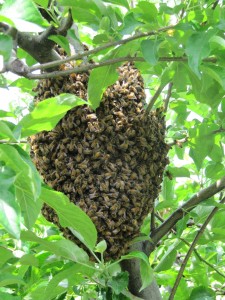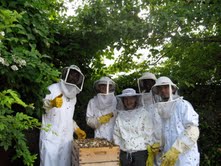New Buzz: Keeping Bees in the Bronx and Beyond
Posted in Learning Experiences, Wildlife on September 15 2010, by Plant Talk
Learn About This Popular Urban Hobby in Dig in! Adult Ed Course
 |
Sara Katz is the Community Horticulturist for Bronx Green-Up, the community outreach program of The New York Botanical Garden, and a hobbyist Bronx beekeeper. She will teach Beekeeping Basics at the Midtown Education Center. |
 Beekeeping is proving itself an urban hobby, with hives popping up on rooftops, in backyards, and in community gardens throughout New York City. Even the Botanical Garden has two hives in the Ruth Rea Howell Family Garden.
Beekeeping is proving itself an urban hobby, with hives popping up on rooftops, in backyards, and in community gardens throughout New York City. Even the Botanical Garden has two hives in the Ruth Rea Howell Family Garden.
As a Bronx beekeeper myself, I regularly marvel at the detailed work of the colony: the bright colors of pollen brought back from so many flights, the hoarded honey, and the careful nursing of new life in the brood chamber.
The urban honeybee has faired well this summer, with ample sunshine, and in turn, abundant blooms of plants such as mountain mint (Pycnanthemum virginianum). The leaves of this native perennial make a good tea or can be applied as mosquito repellant. Butterfly bush (Buddlea davidii), a shrub that can tolerate urban pollution and alkaline soils, has tufts of tiny purple flowers on show for months—a perfect plant for pollinators. These and many other flowering plants, from vegetables and herbs to street trees, are visited by bees and other pollinators in great numbers every season.
 One Bronx beekeeper who keeps hives behind a rectory abutting the Genesis Park Community Garden has harvested 275 pounds of honey since July. It tastes floral, minty, and may originate in good part from the nectar of white clover, a spring bloomer found on lawns and other open spaces in the city.
One Bronx beekeeper who keeps hives behind a rectory abutting the Genesis Park Community Garden has harvested 275 pounds of honey since July. It tastes floral, minty, and may originate in good part from the nectar of white clover, a spring bloomer found on lawns and other open spaces in the city.
I once obtained a swarm at the Quaker cemetery in Prospect Park after an old, sick tree was brought down. The chainsaws were chopping up the trunk, and suddenly thousands of bees flew out at the working arborists. One happened to be my friend and former Bronx Green-Up employee, Luis Lemus. He knew I had some bee experience—and a suit—and told me to come on down with my bee box. So in the fading light of a warm October day (warm is important as bees need to maintain a colony temperature of about 92°F), we picked up bees and comb by the handful (not recommended) and arranged them in their new home, an empty hive body. I then loaded my new creatures into a Nissan Sentra (also not recommended, but the hive was sealed up), and delivered them to their new home, a second-story sundeck off my apartment in the Gowanus section of Brooklyn.
Since then I’ve had more beekeeping adventures in New York City than one might imagine—in community gardens, backyards, even the Bronx Zoo, where they keep bees to feed to a type of African bird, one that flies into the air and catches a bee in its skinny beak for a meal. It works every time.
For more adventures in beekeeping and to learn how to build and maintain a hive, come take my one-day class Beekeeping Basics on the evening of October 6 at the Garden’s new Midtown Education Center in Manhattan.
Beekeeping Basics is one of dozens of Dig in! courses offered by the Botanical Garden’s Adult Education department to help you explore your greener side.


May I share also that raising bees in a controlled environment to be able to gather honey is what beekeeping is all about. This practice has been done for thousands of years, but the present technique of beekeeping started in the 19th century. Beekeeping enthusiasts rave about how fascinating this hobby can be. Not only that, it can also become a money-making venture. But to flourish in beekeeping, one has to have a good amount of knowledge in the process of keeping bees.